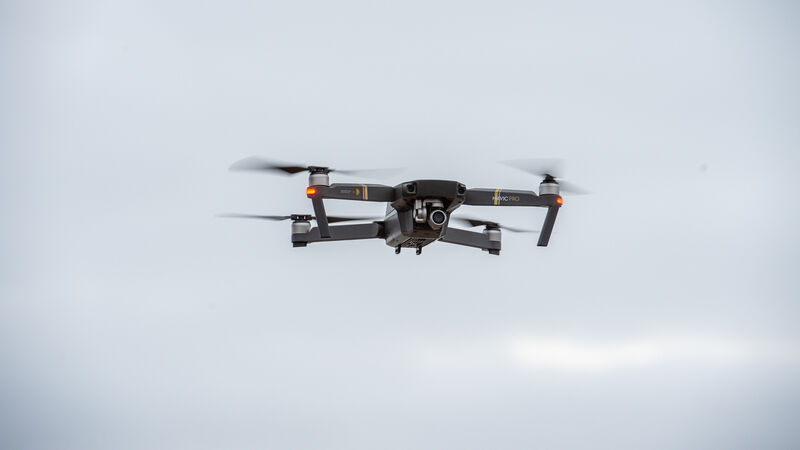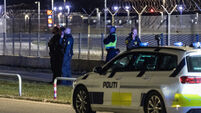Irish Examiner view: Drone technology presents challenges at home and abroad

Drone technology is relatively cheap and remotely operated, which makes it very attractive to a state aiming to terrorise and provoke its targets. Picture: Dan Linehan
Is there a recent innovation which has attracted more negative connotations than the drone?
These tiny aircraft feature in the headlines regularly, and rarely for positive reasons. Concerns about privacy and noise pollution caused by drone deliveries have been expressed in Dublin recently, but such complaints pale in comparison to this week’s incidents abroad.
Twice in recent days, airports have been forced to close due to drone activity: Copenhagen Airport in Denmark was shut down for several hours on Monday after drones were sighted, while Oslo Airport in Norway also had to suspend operations. The situation escalated further when Aalborg Airport in northern Denmark was also forced to close temporarily.
Aalborg is used for both commercial and military flights. The Danish authorities have described the drone activity as part of a hybrid attack which was a serious challenge to its critical infrastructure.
Suspicious drones have also been sighted over Germany recently, while two weeks ago, drones set off a military alert in Poland when entering that country’s airspace.
There is widespread speculation that Russia is responsible, which is hardly a surprise given the location of the affected countries. Russia is also in the middle of an open conflict with Ukraine where drone warfare is one of the main theatres of combat.
Analysts suggest that such drone attacks may be part of a Russian strategy to test Nato’s stomach for confrontation — that Russia wants to see how far it can prod and poke various countries before they retaliate.
This may be a fair assessment of Russian president Vladimir Putin’s intentions, but it does not offer a clear solution to the problem posed by drone incursions.
The technology is relatively cheap — some of the Ukrainian attack drones cost no more than a couple of hundred dollars — and remotely operated, which makes it very attractive to a state aiming to terrorise and provoke its targets.
Countering that technology remains a serious challenge that affects us all.
When comparing how certain behaviours which were widespread in the past are no longer accepted, tolerance of drink-driving is surely one of the best illustrations of changing attitudes change. The blasé mindset of the 1970s and ’80s, when drivers routinely got behind the wheel of a car after consuming significant amounts of alcohol, is a thing of the past.
At least one thought so. It was disturbing this week to read that research carried out for the Road Safety Authority’s (RSA) Blood on Your Hands safety campaign suggested that not only does drink-driving appear to be on the increase, there has also been a 12% rise in the social acceptability of such behaviour between 2019 and 2023.
To take the first of those challenges, the raw data seems to bear out the rise in drink-driving. In the first half of 2025, for instance, nearly 6,000 people were convicted of drink-driving, an increase of 24% in comparison to the first six months of 2024.
That total is enough to give us pause on its own, because it means there are thousands of people on the road who are driving vehicles while their judgement is significantly impaired. That is a frightening prospect in and of itself, particularly given the high number of road fatalities in recent years.
The growing tolerance of drink-driving is almost as ominous, because it lessens the impact of any sanction taken against a driver under the influence of drink; if the offence itself is not seen as serious, how can the sanctions imposed be taken seriously?
Scholarly studies are no doubt under way to determine what has caused this acceptance of drink-driving, but that does not solve our immediate problem with such drivers.
The thrust of the RSA’s campaign — to make drink drivers feel like “social outcasts” — is praiseworthy, but is it enough?
Serious legal consequences such as drink drivers losing their licences, being barred from driving for long periods, and receiving prison sentences may be criticised as draconian, but more potent disincentives are needed to solve this problem.
The Oasis circus has long moved on from Croke Park, leaving a trail of bucket hats and 90s-era merchandise in its wake.
And some buyer’s remorse, perhaps. It might have been forgotten already, but when tickets went on sale for the band’s reunion tour there was a good deal of unhappiness about ticket prices, with Ticketmaster widely criticised for its "dynamic pricing" model.
In that system, tickets rise in price as a response to demand — what that meant for fans in online queues was a rude surprise when they ended up with far higher ticket prices than they had bargained for. Little wonder Ticketmaster was criticised in Britain for not keeping such fans informed of the realities of dynamic pricing.
Such was the outcry, in fact, that the competition and markets authority in Britain now says Ticketmaster has agreed to tell fans 24 hours in advance if a tiered pricing system is being used — as was the case with Oasis tickets — and to give more information about ticket prices during online queues.
This seems eminently sensible in an era when the old-fashioned approach to ticket purchases — buying one over the counter in a record shop is long gone. We await developments from our Competition and Consumer Protection Commission, due to report on this matter soon.
















